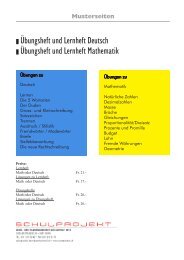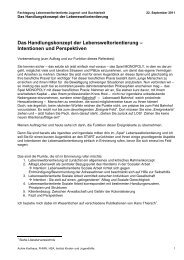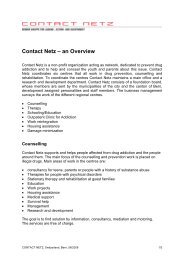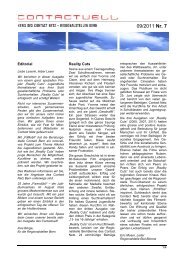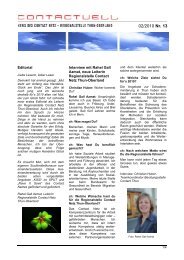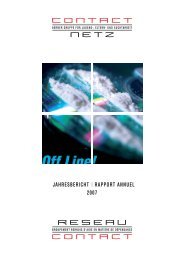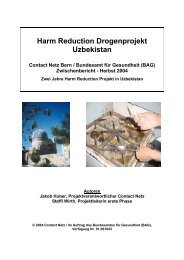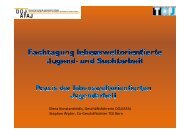Harm Reduction Drug Project Uzbekistan - Contact Netz
Harm Reduction Drug Project Uzbekistan - Contact Netz
Harm Reduction Drug Project Uzbekistan - Contact Netz
Create successful ePaper yourself
Turn your PDF publications into a flip-book with our unique Google optimized e-Paper software.
1. Abstract<br />
BACKGROUND The number of injecting heroin addicts has risen sharply in<br />
<strong>Uzbekistan</strong> in the past few years in all sections of society. This has gone hand in<br />
hand with the spread of HIV/AIDS and Hepatitis C. Since Uzbek drug policy and<br />
efforts to combat drug abuse are to a great extent inadequate and overstretched<br />
there is little likelihood of dealing with the massive problem of heroin addiction<br />
without international support. A model project focusing on harm reduction and on<br />
helping drug addicts to survive, was developed with support from the Swiss<br />
government, inspired by the four-pillar model on which Switzerland’s own drug<br />
policy is based. The dissemination of information about HIV/AIDS and Hepatitis C,<br />
and the provision of clean syringes and condoms and related counselling services,<br />
should help to reduce the frequency of HIV and Hepatitis C infections in<br />
<strong>Uzbekistan</strong>.<br />
METHODS Co-operation with NGOs in Tashkent and Samarkand, creating <strong>Contact</strong><br />
Centres, confidence-building with drug addicts, the “snowball” system, supplying<br />
syringes with the help of volunteers, involving the community and drug addicts<br />
themselves, strategic integration through the co-operation between <strong>Uzbekistan</strong> and<br />
Switzerland, and between the Tashkent Steering Committee, the Swiss Embassy<br />
and higher-level Uzbek officials in the Public Health, Justice and Police<br />
Departments.<br />
INDICATORS OF SUCCESS The number of syringes distributed and returned, the<br />
number of condoms distributed, the take-up of services offered by the Samarkand<br />
and Tashkent <strong>Contact</strong> Centres, adoption of the model project as part of the normal<br />
services provided by the healthcare systems in <strong>Uzbekistan</strong> and Central Asia, a<br />
Central Asian drug policy focused on harm reduction, and a drug strategy based on<br />
the Swiss four-pillar model.<br />
RESULTS Greater understanding of and support for harm reduction among<br />
government representatives, distribution of 300,000 syringes in six months, 1,200-<br />
1,500 heroin addicts supplied with syringes, condoms and information. Access to<br />
drug addicts’ is far greater via <strong>Contact</strong> Centres than via government-run Trust<br />
Points.<br />
CONCLUSIONS The difficulty of implementing a harm reduction approach within<br />
the context of Uzbek drug policy, a trailblazing project that makes sense, lasting<br />
prospects, endangered by financial problems, the limitations of an institutionalised<br />
harm reduction strategy, the need for changes in attitudes , confidence, long-term<br />
prospects and financing, and also for cultural change.<br />
4





